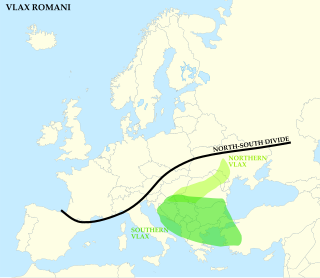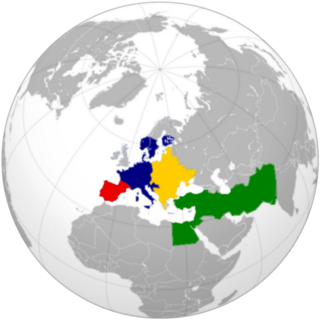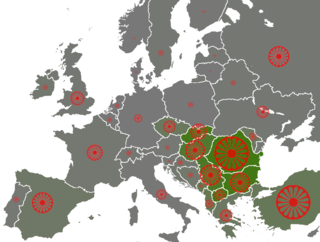
The Romani, also spelled Romany or Rromani and colloquially known as the Roma, are an ethnic group of Indo-Aryan origin who traditionally lived a nomadic, itinerant lifestyle. Linguistic and genetic evidence suggests that the Romani originated in the Indian subcontinent, in particular the region of present-day Rajasthan. Their subsequent westward migration, possibly in waves, is now believed by historians to have occurred around 1000 CE. Their original name is from the Sanskrit word डोम, doma and means a member of the Dom caste of travelling musicians and dancers. The Roma population moved west into the Persian Ghaznavid Empire and later into the Byzantine Empire. The Roma are thought to have arrived in Europe around the 13th to 14th century. Although they are widely dispersed, their most concentrated populations are located in Bulgaria, Hungary, Romania, Spain, and Turkey.
Romani is an Indo-Aryan macrolanguage of the Romani communities. According to Ethnologue, seven varieties of Romani are divergent enough to be considered languages of their own. The largest of these are Vlax Romani, Balkan Romani (600,000), and Sinte Romani (300,000). Some Romani communities speak mixed languages based on the surrounding language with retained Romani-derived vocabulary – these are known by linguists as Para-Romani varieties, rather than dialects of the Romani language itself.
The Romano-Serbian language is a mixed language resulting from language contact between Serbian and Romani in Serbia and former Yugoslav countries and distinct from the Vlax Romani dialects spoken in Serbia.

The Romani Holocaust or the Romani genocide was the planned effort by Nazi Germany and its World War II allies and collaborators to commit ethnic cleansing and eventually genocide against European Roma and Sinti peoples during the Holocaust era.

Romani music is the music of the Romani people who have their origins in northern India but today live mostly in Europe.

The Sinti are a subgroup of Romani people. They are found mostly in Germany, France and Italy and Central Europe, numbering some 200,000 people. They were traditionally itinerant, but today only a small percentage of Sinti remain unsettled. In earlier times, they frequently lived on the outskirts of communities.

Vlax Romani is a dialect group of the Romani language. Vlax Romani varieties are spoken mainly in Southeastern Europe by the Romani people. Vlax Romani can also be referred to as an independent language or as one dialect of the Romani language. Vlax Romani is the second most widely spoken dialect subgroup of the Romani language worldwide, after Balkan Romani.
The Romani language has for most of its history been an entirely oral language, with no written form in common use. Although the first example of written Romani dates from 1542, it is not until the twentieth century that vernacular writing by native Romani people arose.
Gurbeti are a sub-group of the Romani people living in Cyprus and North Cyprus, Turkey, Crimea, Albania, Serbia and the former Yugoslavia whose members are Eastern Orthodox and predominantly Muslim Roma. The Gurbeti make up approximately two thirds of the population of Roma in Macva, many of whom work in agriculture. In Kosovo, other Romani groups viewed the Gurbeti negatively.

Roma, traditionally Țigani, constitute one of Romania's largest minorities. According to the 2011 census, their number was 621,573 people or 3.3% of the total population, being the second-largest ethnic minority in Romania after Hungarians. There are different estimates about the size of the total population of people with Romani ancestry in Romania, varying from 4.6 per cent to over 10 percent of the population, because many people of Romani descent do not declare themselves Roma. For example, in 2007 the Council of Europe estimated that approximately 1.85 million Roma lived in Romania, based on an average between the lowest estimate and the highest estimate available at the time. This figure is equivalent to 8.32% of the population.
The Romani people, also referred to as Roma, Sinti, or Kale, depending on the subgroup, are an Indo-Aryan ethnic group that primarily lives in Europe. The Romani may have migrated from what is the modern Indian state of Rajasthan, migrating to the northwest around 250 BC. Their subsequent westward migration, possibly in waves, is now believed to have occurred beginning in about 500 AD. It has also been suggested that emigration from India may have taken place in the context of the raids by Mahmud of Ghazni. As these soldiers were defeated, they were moved west with their families into the Byzantine Empire.

The Kalderash are a subgroup of the Romani people. They were traditionally coppersmiths and metal workers and speak a number of Romani dialects grouped together under the term Kalderash Romani, a sub-group of Vlax Romani.

The Romani people have several distinct populations, the largest being the Roma and the Calé, who reached Anatolia and the Balkans in the early 12th century, from a migration out of the Indian subcontinent beginning about 1st century – 2nd century AD. They settled in the areas of present-day Turkey, Greece, Serbia, Romania, Croatia, Moldova, Bulgaria, North Macedonia, Hungary, Albania, Kosovo, Bosnia and Herzegovina, Czech Republic, Slovenia and Slovakia, by order of volume, and Spain. From the Balkans, they migrated throughout Europe and, in the nineteenth and later centuries, to the Americas. The Roma population in the United States is estimated at more than one million.

Muslim Romani people are people who are ethnically Roma and profess Islam. There are many different Roma groups and subgroups that predominantly practice Islam, as well as individual Romani people from other subethnic groups who have accepted Islam. Xoraxane Roma in Balkan Romani language, are non-Vlax Romani people, who adopted Sunni Islam of the Hanafi madhhab at the time of the Ottoman Empire. Some of them are Derviş of Sufism belief, and the biggest Tariqa of Jerrahi is located at the largest Arlije and Gurbeti Muslim Roma settlement in Europe in Šuto Orizari, locally called Shutka in North Macedonia have their own Romani Imam and the Muslim Roma in Šuto Orizari use the Quran in Balkan Romani language. Many Romanlar in Turkey, are members of the Hindiler Tekkesi a Qadiriyya-Tariqa, founded in 1738 by the Indian Muslim Sheykh Seyfullah Efendi El Hindi in Selamsız. Roma Muslims in Turkey and the Balkans are mostly cultural Muslims or nominal Muslims.
The Romani people are known by a variety of names, mostly under the broad categories of gipsy, tsinganoi, Bohémiens, and Roma. Self-designation varies: In Central and Eastern Europe, Roma is common. The Romani of England call themselves Romanichal, those of Scandinavia Romanisæl. In German-speaking Europe, the self-designation is Sinti, in France Manush, while the groups of Spain, Wales, and Finland use Kalo/Kale. There are numerous subgroups and clans with their own self-designations, such as the Kalderash, Machvaya, Boyash, Lovari, Modyar, Xoraxai, and Lăutari.
Lovari is a subgroup of the Romani people, who speak their own dialect, influenced by Hungarian and West Slavic dialects. They live predominantly throughout Central Europe as well as in Southeastern Europe.

Romani Americans are Americans who have full or partial Romani ancestry. It is estimated that there are one million Romani people in the United States. Though the Romani population in the United States has largely assimilated into American society, the largest concentrations are in Southern California, the Pacific Northwest, Southwestern United States, Texas, Louisiana, Florida and the Northeast as well as in cities such as Chicago and St. Louis.

The Romani are an ethnic group that has lived in Austria since the Middle Ages. According to the 2001 census, there were 6,273 Romani speakers in Austria, or less than 0.1% of the population. Estimations count between 10,000 and 25,000. A more recent estimation count between 40,000 and 50,000 Romani people or about 0.5%. Most indigenous Romani people in Austria belong to the Burgenland-Roma group in East-Austria. The majority live in the state of Burgenland, in the city of Oberwart and in villages next to the District of Oberwart. The Burgenland-Roma speak the Vlax Romani language.

Hungarian-Slovak Roma or Balshade immigrated to the United States in the late 19th century, many from Košice, Slovakia. They settled in the cities of Braddock, Homestead, Johnstown, and Uniontown, Pennsylvania; Cleveland and Youngstown, Ohio; Detroit and Delray, Michigan; Gary, Indiana; Chicago, and New York City and Las Vegas. The Hungarian-Slovak Roma were a community of settled Roma, and in the United States were well known for playing music for the Central European immigrant communities in which they settled. These Roma were known for playing in cafes and restaurants, the name associating these Romani as Bashaldé was made up in late 20th century, and in Hungary they are called Romungro Romani; portions of them were also known as Romungre. In the early 1900s the Roma in Braddock, Pennsylvania, purchased an entire block of homes, making them the largest population of settled Roma in the United States.

Romani dress is the traditional attire of the Romani people, widely known in English by the exonymic slur Gypsies. Romani traditional clothing is closely connected to the history, culture, and national identity of the Roma people.












